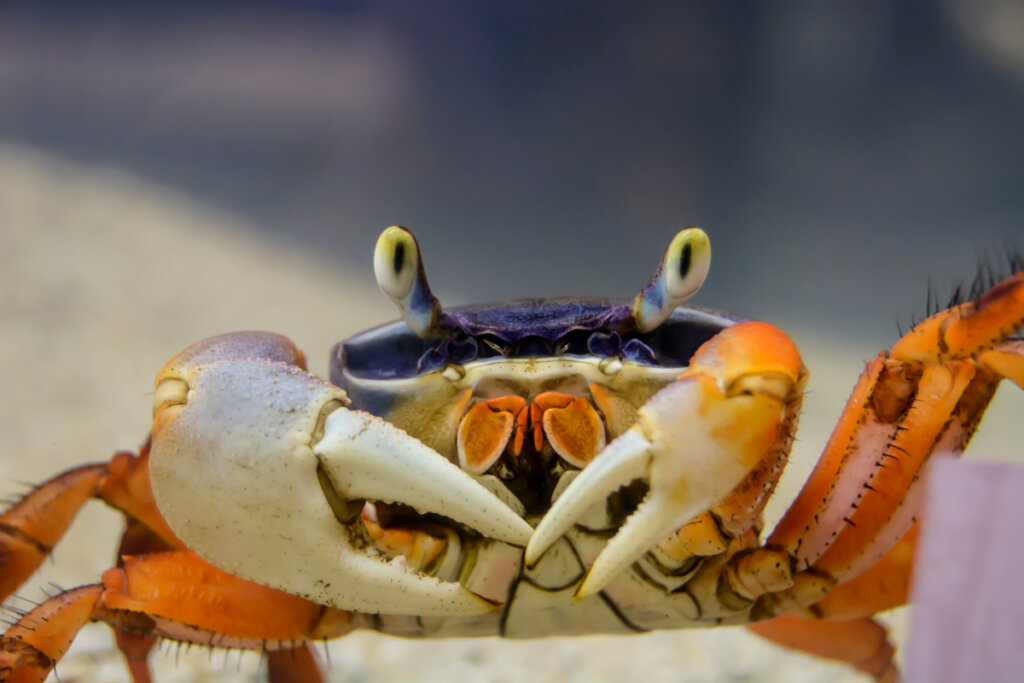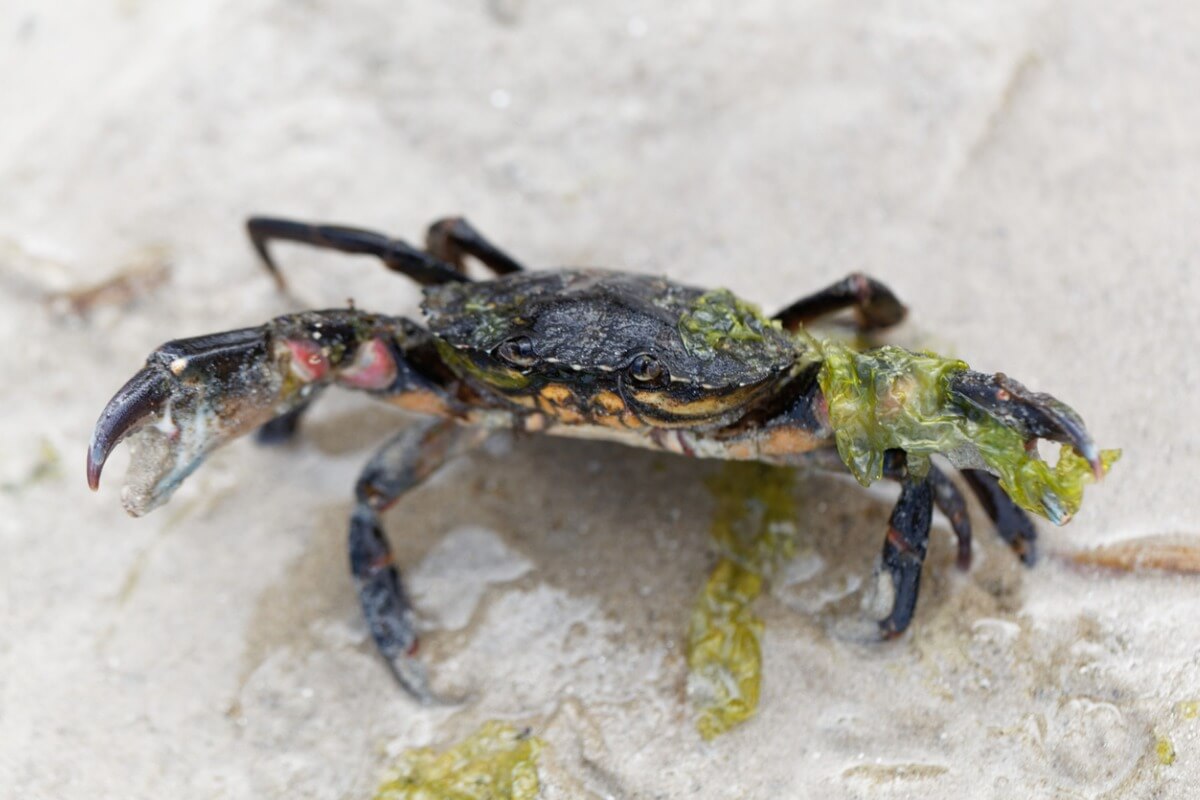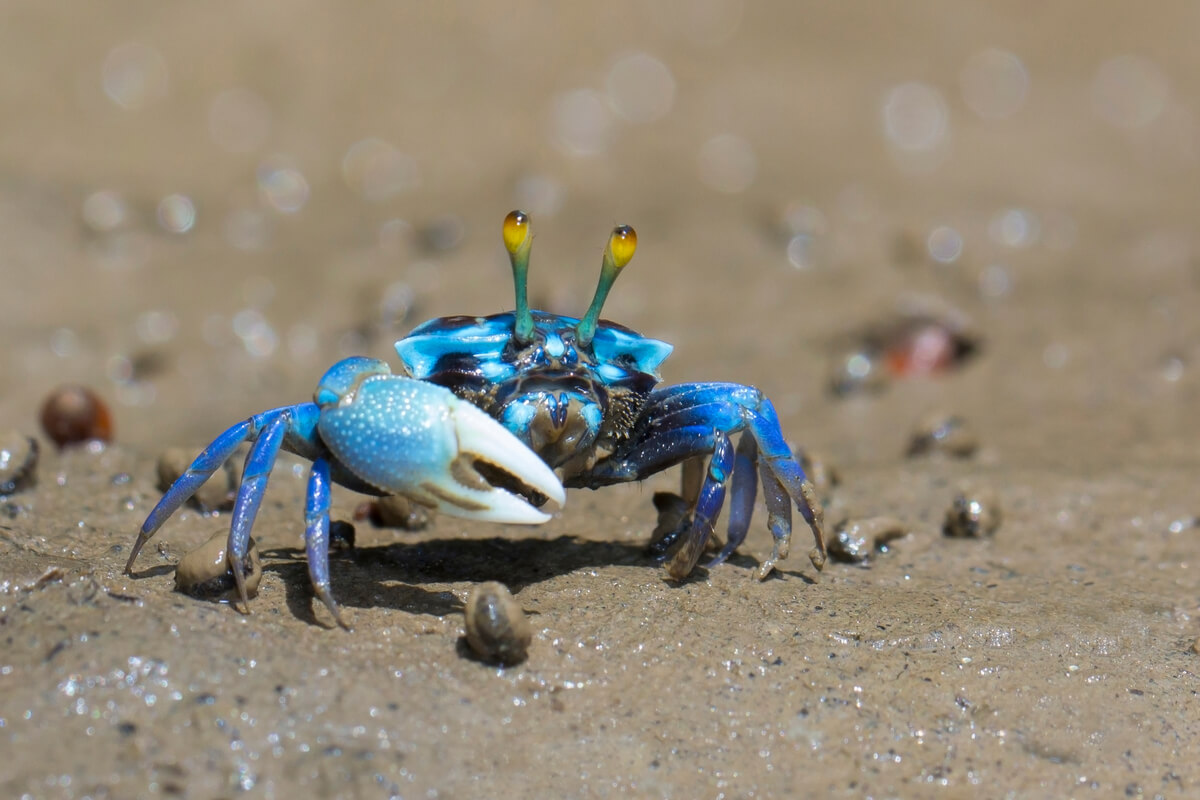Types of Crabs: Their Characteristics, Behavior and Reproduction

When walking on the beach, you’ll quite often see bubbles in the sand that seem to come from the ground. The locals may tell you that it’s the crabs breathing, but nothing could be further from the truth. Actually, this “sand foam” is due to the flow of air through the capillaries, something that has nothing to do with crabs. Anyway, we’re going to be telling you about different types of crabs today, so keep reading!
Many myths and preconceptions have been created in relation to crabs, as these invertebrates are elusive and it’s often difficult to observe them. Here we’ll tell you everything you need to know about the order of the decapods and their representatives.
Types of crabs and their characteristics
Within the group of metazoans, there’s a general classification between vertebrate and invertebrate animals. The former have an internal skeleton, while the latter has an external one. Crabs are part of the invertebrate group, as they have a chitin exoskeleton that can be seen with the naked eye.
On the other hand, when it comes to taxonomically classifying them, most – but not all – crabs are included within the Brachyura infraorder. When talking about its characteristics, we can cite the following as the most striking:
- Diurnal decapods: The number of legs and their type of activity are common classifying traits. Thus, as this group has 5 pairs of legs, its members are called decapods.
- Omnivorous arthropods: They’re omnivores, and their diet is very varied. But, if you give them a choice, they’ll always choose shrimp, as this seems to be their favorite food. However, under normal circumstances, their diet depends on both the availability of resources and the species of crab. These invertebrates usually feed on algae, other invertebrates, fish, fungi, bacteria, or detritus.
- Sexual dimorphism: Males are usually larger than females, although this isn’t the only striking feature between the sexes. For example, their claws don’t have to be symmetrical, like those of fiddler crabs, which belong to the genus Uca. The claws are uneven in males and are adapted to the different activities of their day-to-day lives.
- They have a multi-colored shell: Depending on the species of crab, their shell will show different shades or even patterns, all influenced by the habitat. For this reason, crabs aren’t only red as we may think; they have shades of blue, green, yellow, brown, and many other colors.

Types of crabs
Crabs can be classified in several ways, either by looking at their size, the conditions of their habitat or others. Below are two of the classifications —although they don’t have to be the most common ones.
- By size: Two opposite cases are Pinnotheres pisum or pea crabs – around a centimeter (0.4 inches) – and the Macrocheira kaempferi, or Japanese spider crab, which can reach 20 kilos (44 pounds) in weight and up to 4 meters (13 feet) in length.
- Habitat: Most crabs live in ocean waters, while others live in fresh water. Although they also spend a lot of time on land, they won’t stray more than 5 kilometers (3 miles) from shore. This results in a clear differentiation between crayfish and sea crabs.
Behavior and reproduction
Zoologists who have studied this group have observed that crabs are very dynamic animals. In addition, they’re characterized by their complex behavior, some of which may not be too well known. We’ll show you five examples of this.
1. Some crabs walk sideways
When imagining how a crab walks, we usually visualize the animal walking to one side. However, some species of crabs have modified this behavior: they walk forward or backward. Surprisingly, others are capable of climbing trees. This is the case of the coconut crab (Birgus latro), which climbs the coconut trees to provide itself with an essential food in its diet: coconuts.
2. They show aggressive behavior
When it comes to capturing the attention of a female, males display aggressive behavior. Normally, they fight each other for the right to mate with females. However, they also do it to choose the best dens. In them, the crabs take refuge and hide from their predators: sea birds, fish, cephalopods, and otters.
3. They aren’t great swimmers
There’s a general belief that, as they live in water, these decapods have to be good swimmers. This isn’t always the case, as, whether they’re on the beach, at the shore, on the bottom of the sea, or in lakes and rivers, crabs move by walking on the sand. However, there are some exceptions, such as the Portunidae and Matutidae families.
4. Its pincers are its main communicative element
Crabs’ communication mechanisms follow complex patterns, and their claws stand out as a fundamental element. Thanks to them, they create noises reminiscent of drums. Sometimes they wave them too, with the aim of intimidating their opponents.
5. During the mating season, they cooperate fully
Crabs cooperate fully during the mating season. Mainly, they’re in charge of the food supply, as well as the protection of their family group. The latter includes finding a suitable place to release the eggs.

In short, there are many types of crabs, and they’re subdivided into different families, genera, and species. Within this group, you can find species whose names really grab your attention, such as the vampire crab (Geosesarma sp.) or the rainbow crab (Cardisoma armatum).
However, there are also many other less striking ones – such as Carcinus maenas – but which have an essential function for ecosystems. These invertebrates are part of the middle section of many food chains, and so looking after them is essential to ensure marine environments don’t collapse.
All cited sources were thoroughly reviewed by our team to ensure their quality, reliability, currency, and validity. The bibliography of this article was considered reliable and of academic or scientific accuracy.
- Comportamiento de los cangrejos. Cangrejopedia. Accedido el 29 de abril de 2021 en: http://www.cangrejopedia.com/comportamiento-de-los-cangrejos/
- Cangrejos. Aquarium Costa de Almería. Accedido el 29 de abril de 2021 en: https://www.aquariumcostadealmeria.com/curiosidades/cangrejos/